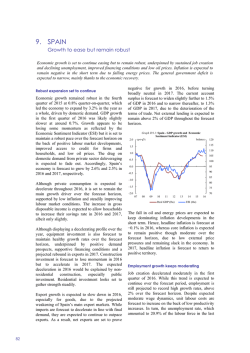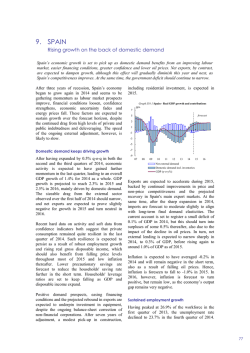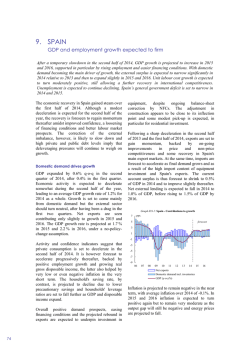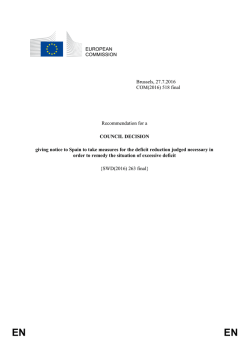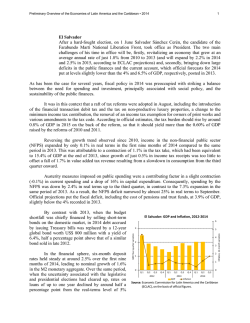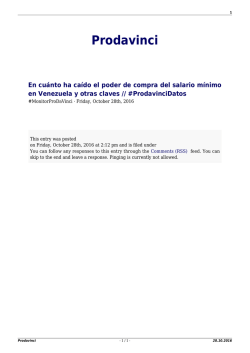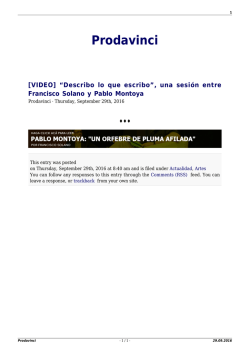
9. SPAIN
9. SPAIN Growth expected to decelerate but remain robust Economic growth has again exceeded expectations in recent quarters. It is still expected to ease but remain robust throughout the forecast horizon. Although domestic demand is expected to remain the main driver of growth, the contribution of the external sector is set to turn positive. Inflation is expected to pick up in 2017 as oil prices increase and core inflation recovers. Unemployment is set to continue to fall steadily to 16½% by 2018. The reduction of the general government deficit in 2017 and 2018 relies to a large extent on the positive macroeconomic outlook. Upward revision to growth in 2016 The pace of economic growth again exceeded expectations in the first three quarters of 2016, when GDP grew by 0.8% quarter-on-quarter in both the first and second quarters and by 0.7% in the third quarter. Accordingly, Spain’s economy is forecast to grow by 3.2% in 2016 as a whole, revised up from 2.6% in the spring forecast. Although domestic demand is expected to remain the main growth driver, the contribution of the external sector to GDP growth is turning positive. external lending is expected to remain at or above 2.4% of GDP over the forecast horizon. 4 Graph II.9.1: Spain - Real GDP growth and contributions pps. forecast 2 0 -2 -4 -6 Growth set to decelerate but remain robust The rate of GDP growth is expected to ease over the forecast horizon to a still relatively robust 2.3% in 2017 and 2.1% in 2018. Private consumption is expected to slow down as employment growth decreases and the tailwinds that supported the growth of disposable income in recent years (i.e. the decline in oil prices and improving financial conditions) gradually abate. Investment growth is expected to ease somewhat in 2017 before increasing again in 2018, driven by the gradual recovery of construction investment, both residential and non-residential. Equipment investment growth, by contrast, is expected to moderate in line with final demand. Export growth is picking up this year compared to 2015, especially for services. It is expected to slow down slightly in 2017 and 2018. However, despite declining in yearly terms, exports are expected to pick up again towards the end of the forecast period as Spain's trading partners recover. At the same time, imports are forecast to decelerate in line with final demand and grow more slowly than exports throughout the forecast horizon. As a result, net exports are set to make a positive contribution to growth also in 2017 and 2018. However, after widening in 2016, Spain’s current account surplus is forecast to marginally decrease in 2017 and stabilise thereafter, under the impact of the expected swings in terms of trade. Net 88 -8 09 10 11 12 13 14 15 16 17 Inventories Net exports Dom. demand excl. invent. Real GDP (y-o-y%) 18 Inflation expected to pick up The assumed oil price increases are set to continue dominating inflation developments in the short term. Hence, headline inflation is forecast to rise from −0.4% in 2016 to 1.6% in 2017, before decreasing slightly to 1.5% in 2018 as the effect of energy price increases fades away. At the same time, core inflation is expected to gradually increase over the forecast horizon. Employment growth expected to moderate Job creation accelerated in the third quarter of 2016 compared to the second quarter, and although it is set to ease over the forecast period, it is projected to remain strong, allowing for further reductions in unemployment. The unemployment rate, which amounted to 18.9% of the labour force in the third quarter of 2016, is expected to continue falling to 16½% by 2018. Continued wage moderation combined with still low productivity gains is set to lead to moderate increases in nominal unit labour costs over the forecast horizon. Member States, Spain Deficit reduction driven by the recovery, while remaining high Despite strong economic growth, Spain’s general government deficit barely changed in the first half of 2016. Available monthly data for August and September for some subsectors of general government confirmed this picture. Whereas expenditure has grown in line with expectations, revenues have been weighed down by significant shortfalls in income tax revenue. This is especially the case for the corporate income tax following the second leg of the tax reform and the abolition of the minimum advance payments, which came into effect in 2016. To limit the negative impact on the budget balance of the latter, the parliament adopted a Royal Decree Law in October reintroducing the minimum advance payments, with an extended coverage of firms and increased amounts. As a result, the general government deficit is expected to decrease from 5.1% in 2015 to 4.6% in 2016. It is then expected to narrow to 3.8% of GDP in 2017 and is projected to reach 3.2% of GDP in 2018. In the absence of a budget for 2017, the reduction of the deficit in both years relies to a large extent on the positive macroeconomic outlook, which should continue supporting tax revenues and keeping social transfers in check. In particular, while pension expenditure is expected to continue rising, falling unemployment should reduce the growth of social transfers. Previous improvements in financing conditions imply that interest expenditure is set to continue decreasing. After deteriorating significantly in 2015, Spain’s structural deficit is expected to increase further by some 1% of GDP in 2016 and stabilise thereafter. Relatively strong nominal GDP growth largely offsets the still large, though declining, deficit expected over the forecast horizon, allowing the general government debt ratio to remain broadly stable around 100% of GDP. The forecast assumes a planned debt-decreasing stock-flow adjustment of 1.1% of GDP in 2016, as reported in the draft budgetary plan. Table II.9.1: Main features of country forecast - SPAIN 2015 bn EUR GDP Private Consumption Public Consumption Gross fixed capital formation of which: equipment Exports (goods and services) Imports (goods and services) GNI (GDP deflator) Contribution to GDP growth: Annual percentage change Curr. prices % GDP 97-12 2013 2014 2015 2016 2017 2018 1075.6 100.0 2.2 -1.7 1.4 3.2 3.2 2.3 2.1 625.0 58.1 1.9 -3.1 1.6 2.9 3.2 2.1 1.6 208.5 19.4 3.5 -2.1 -0.3 2.0 0.9 0.8 0.8 212.1 19.7 1.8 -3.4 3.8 6.0 4.2 3.6 3.8 72.7 6.8 2.9 5.0 8.3 8.9 6.7 4.5 3.9 356.9 33.2 4.5 4.3 4.2 4.9 6.1 4.5 4.4 330.5 30.7 4.2 -0.5 6.5 5.6 5.8 4.3 4.1 1074.9 99.9 2.2 -1.5 1.6 3.5 3.2 2.2 2.1 2.3 -2.9 1.6 3.2 2.9 2.1 1.9 0.0 -0.2 0.3 0.1 0.1 0.0 0.0 0.0 1.5 -0.5 -0.1 0.2 0.2 0.2 1.3 -3.5 1.1 3.0 2.8 2.1 1.8 14.1 26.1 24.5 22.1 19.7 18.0 16.5 3.0 1.4 -0.1 0.4 1.2 1.2 1.4 2.1 -0.5 -0.4 0.2 0.8 1.1 1.1 -0.4 -0.8 -0.1 -0.3 0.1 -0.1 -0.4 Domestic demand Inventories Net exports Employment Unemployment rate (a) Compensation of employees / f.t.e. Unit labour costs whole economy Real unit labour cost Saving rate of households (b) GDP deflator Harmonised index of consumer prices Terms of trade goods Trade balance (goods) (c) Current-account balance (c) Net lending (+) or borrowing (-) vis-a-vis ROW (c) General government balance (c) Cyclically-adjusted budget balance (d) Structural budget balance (d) General government gross debt (c) 10.2 9.6 9.0 8.2 8.4 8.4 8.4 2.6 0.4 -0.3 0.5 0.7 1.2 1.5 2.7 1.5 -0.2 -0.6 -0.4 1.6 1.5 -0.2 0.6 -0.5 2.0 0.8 -0.9 -0.4 -5.5 -1.4 -2.2 -2.0 -1.9 -2.1 -2.2 -4.6 1.5 1.0 1.3 1.7 1.5 1.5 -3.9 2.1 1.5 2.0 2.6 2.4 2.4 -3.1 -7.0 -6.0 -5.1 -4.6 -3.8 -3.2 -3.2 -2.5 -2.3 -3.0 - -3.8 -3.8 -3.8 - -2.0 -1.9 -2.8 - -3.8 -3.8 -3.8 54.3 95.4 100.4 99.8 99.5 99.9 100.0 (a) as % of total labour force. (b) gross saving divided by gross disposable income. (c) as a % of GDP. (d) as a % of potential GDP. 89
© Copyright 2024
